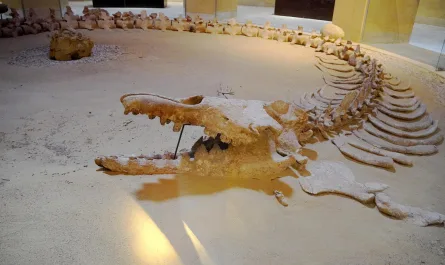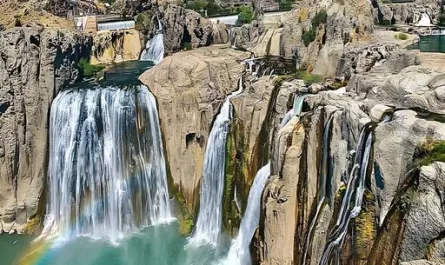The Roman Amphitheater of Mastaura: A Glimpse into Ancient Anatolia’s Arena of Spectacle
In the rolling hills of Aydın Province, Turkey, near the ancient city of Mastaura, lies a remarkable relic of the Roman Empire: a 1,800-year-old amphitheater discovered in 2020. Dating to around A.D. 200, this well-preserved structure, capable of seating 15,000 to 20,000 spectators, hosted thrilling gladiator battles and wild animal shows. While smaller than Rome’s Colosseum, its intact features—underground gladiator rooms, seating rows, and private entertainment spaces—offer a vivid window into Roman entertainment and architecture in Anatolia. As of 2025, ongoing conservation efforts using laser scanning and digital mapping are ensuring this unique site continues to reveal its secrets.
Discovery and Historical Context
The amphitheater was uncovered in the summer of 2020 by archaeologists from Adnan Menderes University, led by Sedat Akkurnaz, with support from Aydın’s Directorate of Culture and Tourism under Mehmet Umut Tuncer. Hidden beneath olive and fig groves and centuries of overgrowth, the structure was identified using 18th-century European travelers’ accounts that described a Colosseum-like arena in Mastaura. The discovery, a national first for its circular design, has been hailed as one of the best-preserved amphitheaters in Turkey, with much of its underground structure described as “solid as if it was just built.”
Built during the Severan Dynasty (A.D. 193–235), a period when Mastaura flourished economically, the amphitheater reflects the city’s wealth and cultural prominence. The Severan era saw increased coin production and architectural development in the region, with Roman administrators fostering growth in this part of ancient Caria, near the Maeander River valley. The arena likely drew spectators from nearby cities like Aphrodisias, Ephesus, Magnesia, Miletus, and Priene, who gathered to bet on and witness bloody spectacles.
Architectural Features
Unlike the more common half-moon theaters of the ancient world, Mastaura’s amphitheater is fully oval, mirroring the design of Rome’s Colosseum, though smaller in scale. The Colosseum, built in A.D. 70–80, could hold 50,000–80,000 spectators, while Mastaura’s arena accommodated 15,000–20,000. Measuring approximately 100 meters in diameter with walls up to 14–15 meters high, the structure features classic Roman architectural elements, including arched and vaulted construction techniques.
Key features include:
- Central Arena: The 131-by-98-foot central area, now filled with earth and vegetation, was the stage for gladiatorial combat and wild animal fights, designed specifically for these “bloody shows.”
- Underground Rooms: Structurally sound chambers beneath the outer walls served as waiting areas for gladiators, spaces for event organizers, and private entertainment rooms for elite spectators, similar to those at the Colosseum.
- Seating and Arches: Rows of seats and supporting walls, some still visible above ground, showcase the arena’s capacity to host large crowds. The outer arches, made of finely crafted stonework, remain partially intact.
The amphitheater’s preservation is attributed to its burial under soil and vegetation, which protected it from looting and environmental damage. Unlike other Anatolian amphitheaters, which have largely collapsed or been repurposed, Mastaura’s arena is a rare example of a well-preserved, purpose-built structure.
Excavation and Conservation Efforts
Since its discovery, the excavation team has cleared shrubs, trees, and debris to reveal the arena’s stonework, with initial surveys completed in 2020–2021. The Turkish Ministry of Culture and Tourism, in collaboration with the Aydın Archaeological Museum and Nazilli Municipality, is leading conservation efforts. As of 2025, the team is addressing cracks in the walls and falling masonry stones to prevent further deterioration.
Advanced technologies are also in use:
- Laser Scanning and Digital Mapping: Archaeologists are employing laser scans to create a virtual 3D model of the amphitheater, aiding in the study of its underground sections without invasive digging.
- Geophysical Surveys: These surveys are planned to map the buried portions, providing insights into the structure’s full layout and hidden features.
These efforts aim to preserve the site while making it accessible for study and, potentially, limited public visitation, though no plans for full public access have been confirmed as of 2025.
Cultural and Historical Significance
The Mastaura amphitheater is a unique find, described as the only well-preserved arena of its kind in Anatolia and its surrounding regions. Its discovery underscores the reach of Roman entertainment culture, which extended far beyond Italy to provinces like Caria. The arena’s design and scale suggest it was a regional hub, drawing crowds for spectacles that reinforced Roman social hierarchies and provided communal entertainment.
The site also sheds light on Mastaura’s role as a prosperous center during the Severan period, supported by evidence of increased coin minting and architectural investment. Its proximity to other ancient cities highlights its integration into a network of cultural and economic exchange in western Anatolia.
Challenges and Future Prospects
Located in an earthquake-prone region, Mastaura’s amphitheater faces risks from seismic activity, which has historically shaped the area’s history of destruction and rebuilding by cultures like the Spartans, Ionians, Persians, and Romans. Conservation efforts must balance preservation with environmental challenges, including potential erosion and vegetation overgrowth. Limited funding and regional instability in Turkey could also hinder long-term maintenance.
Future excavations may uncover additional features, such as artifacts or inscriptions, that reveal more about the gladiators, spectators, and events hosted there. The nearby discovery of a gladiator cemetery in Ephesus, with skeletons showing trauma from combat, suggests Mastaura’s arena could yield similar insights into the lives of its fighters.
Conclusion
The Mastaura amphitheater, unearthed in 2020, is a captivating testament to Roman engineering and entertainment in Anatolia. Its well-preserved state, innovative design, and capacity for 20,000 spectators make it a significant archaeological find, offering a glimpse into the visceral spectacles that defined Roman culture around A.D. 200. As laser scanning and conservation efforts continue, this “Colosseum of Anatolia” promises to deepen our understanding of Mastaura’s role in the Roman world, preserving its legacy for future generations.





